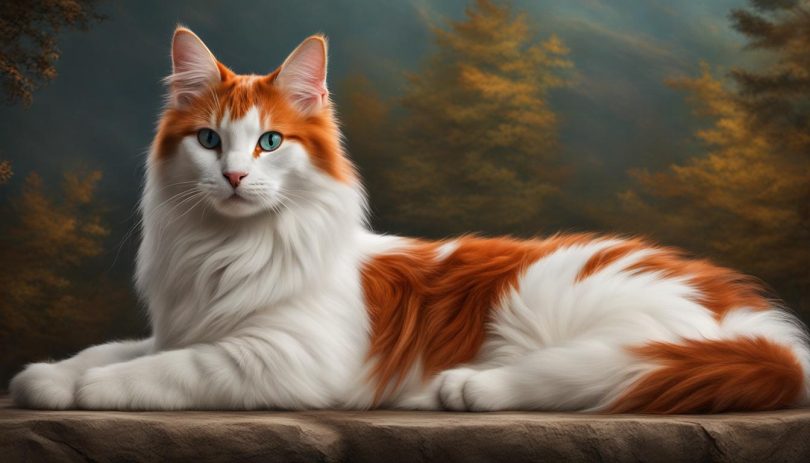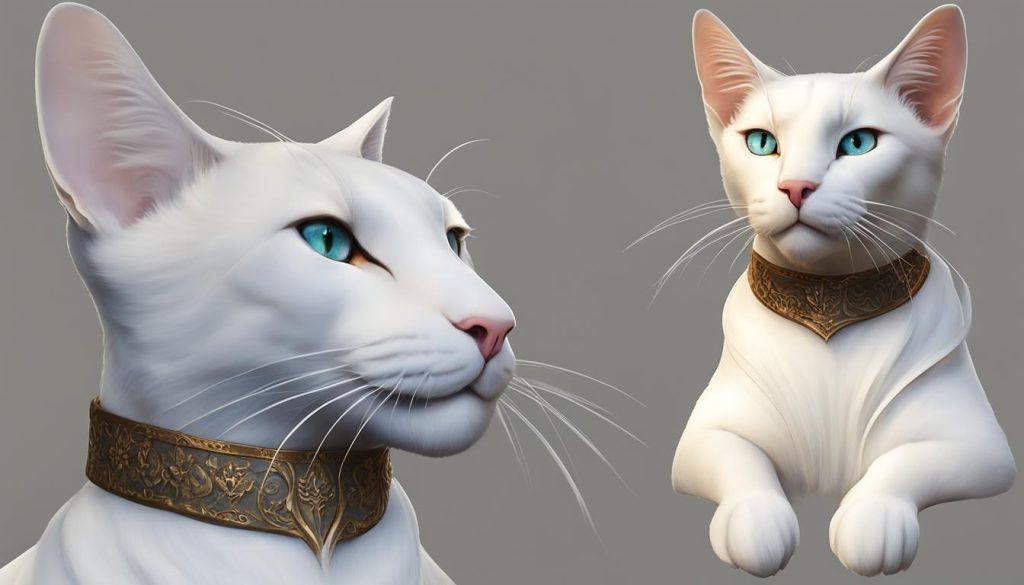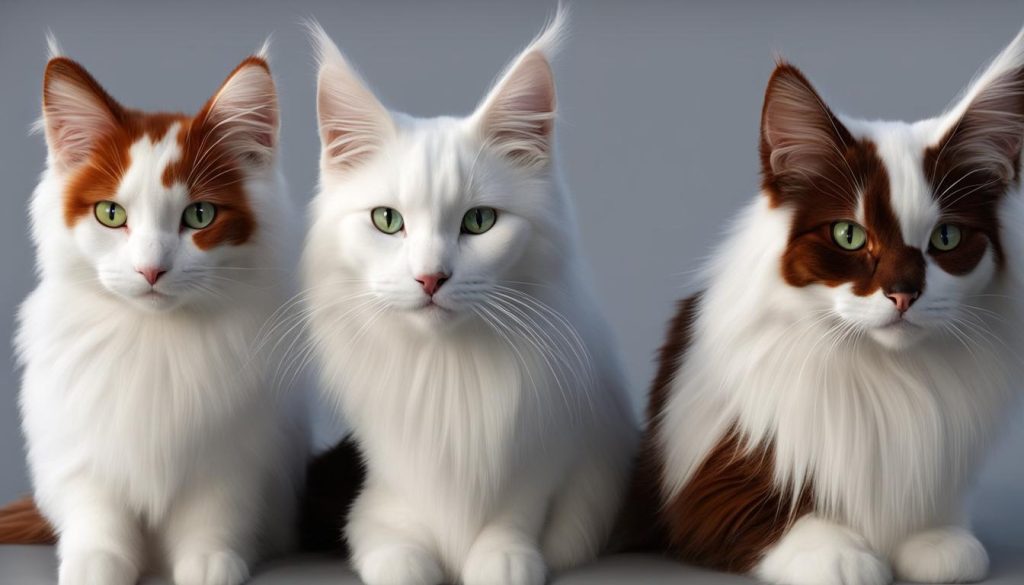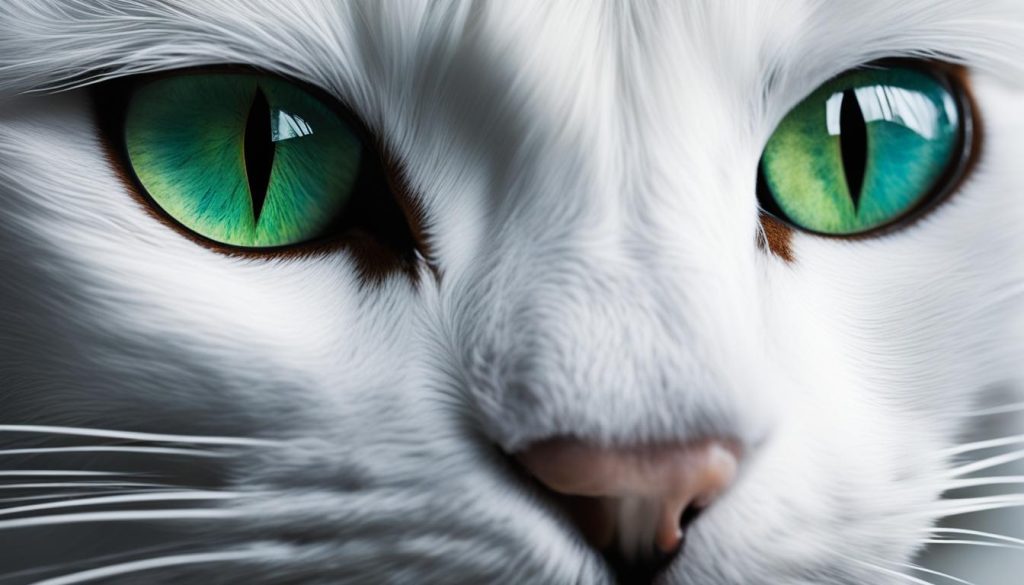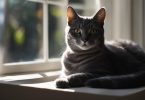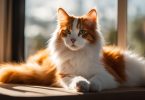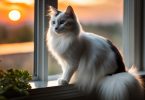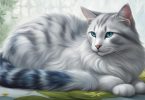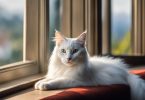Greetings, fellow cat enthusiasts! Today, I invite you to join me on a journey to uncover the alluring size of the Turkish Van, a breed of cat known for its majestic presence. As a proud owner of a Turkish Van myself, I have marveled at their impressive stature and wanted to share my insights with you.
When it comes to the size of the Turkish Van, it’s hard not to be captivated. These feline beauties tower at an average height of 10 to 14 inches, making them quite a sight to behold in any room. But their size doesn’t stop there – they can reach up to a remarkable 3 feet in length from head to tail tip! Now that’s what I call a cat with a commanding presence.
The average weight of a Turkish Van cat ranges from 12 to 20 pounds, reflecting their solid build and muscular frame. However, it’s important to note that individual variations exist, influenced by factors such as gender, genetics, and overall health of the cat.
So, why does size matter? Understanding the size of Turkish Vans can help you better appreciate their unique charm and accommodate their needs. Whether you’re considering bringing a Turkish Van into your family or simply curious about these magnificent felines, delving into their size is a fascinating endeavor.
Key Takeaways:
- Turkish Vans have an average height of 10 to 14 inches at the shoulder.
- They can reach up to 3 feet in length from head to tail tip.
- The average weight of a Turkish Van ranges from 12 to 20 pounds.
- Size variations exist due to factors like gender, genetics, and overall health.
- Understanding the size of Turkish Vans enhances your appreciation for these remarkable felines.
Physical Characteristics: Coat and Tail
The Turkish Van is a breed of cat known for its stunning physical characteristics, including its unique coat and tail. The coat of a Turkish Van is lustrous and can vary in length depending on the season. During the summer months, their coat becomes shorter and lighter, while in the winter, it transforms into a thick and luxuriously long white mane. This seasonal variation adds to the charm and beauty of the breed.
One of the most distinctive features of the Turkish Van is its van pattern of coloration. This pattern consists of a predominantly white body with distinctively colored spots on their heads. These spots can vary in color, and their placement on the head is unique to each individual cat. The tail of a Turkish Van is typically solid-colored and matches the color of the spots on their head.
Overall, the coat and tail of a Turkish Van contribute to its elegant appearance and set it apart from other cat breeds. The combination of a lustrous white coat, unique van pattern, and solid-colored tail creates a visually striking and beautiful feline companion.
Table: Turkish Van Coat and Tail Characteristics
| Coat | Tail |
|---|---|
| Lustrous | Solid-colored |
| Varies in length with seasons | Matches color of head spots |
| Predominantly white with colored spots on head |
As the table and image above illustrate, the coat and tail of a Turkish Van combine to create a visually stunning and unique appearance. The lustrous coat that varies in length with the seasons, along with the van pattern on the head and the solid-colored tail, make the Turkish Van a truly majestic breed. Whether it’s their elegant white coat or their beautifully adorned head and tail, Turkish Vans never fail to captivate with their unrivaled beauty.
Distinguishing Features: Ears and Eyes
When it comes to the distinguishing features of the Turkish Van, its ears and eyes stand out as truly captivating. The breed possesses unique characteristics in these areas that contribute to its overall charm and allure.
Ears:
The Turkish Van’s ears are a sight to behold. They match the color of their tail, creating a striking contrast against their white coat. This color coordination adds to their aesthetic appeal and showcases the breed’s attention to detail in its physical attributes.
Eyes:
The eyes of the Turkish Van are truly mesmerizing. The most common eye color is a captivating shade of blue, which adds to the breed’s elegance and grace. However, some Turkish Vans may have striking gold eyes or even one eye of each color, a condition known as heterochromia. This unique eye coloration further enhances the breed’s beauty and allure.
The slightly oblique shape of the Turkish Van’s eyes, coupled with their larger size, gives the breed a serious yet expressive appearance. Their eyes are windows to their soul and serve as a visual representation of their intelligence and depth of character.
In summary, the Turkish Van’s ears and eyes are distinguishing features that contribute to its overall beauty and charm. The color coordination of the ears with the tail adds an element of elegance, while the mesmerizing eye colors and unique eye shapes make the breed truly captivating.
Turkish Van Head Shape: A Unique Trait
The head shape of the Turkish Van is a defining characteristic that sets this breed apart. With its broad and wedge-shaped structure, the Turkish Van’s head is larger than average, giving it a distinct appearance. The charmingly rounded muzzle adds to the overall appeal of this breed.
The unique head shape of the Turkish Van is a result of its genetics. Breeders have carefully selected for this characteristic to maintain the breed’s standard. The broad head and rounded muzzle contribute to the cat’s overall balance and symmetry, enhancing its regal and majestic presence.
When you look at a Turkish Van, you can’t help but be captivated by its unique head shape. This breed’s head structure is truly a testament to its beauty and elegance. Whether it’s the width of the head or the roundness of the muzzle, the Turkish Van’s head shape is an unmistakable trait that makes this breed one-of-a-kind.
Overall, the Turkish Van’s head shape is a striking feature that adds to its allure. Combined with its other physical characteristics, such as its lustrous white coat and captivating eye colors, the Turkish Van is a breed that commands attention and admiration. Whether you’re a cat lover or simply appreciate the beauty of nature, the Turkish Van’s unique head shape is sure to leave a lasting impression.
Size Comparison: Turkish Van vs Turkish Angora
When it comes to comparing the size of Turkish Van and Turkish Angora cats, there are some noticeable differences to consider. Turkish Vans tend to be larger overall, both in terms of height and length. On average, Turkish Vans stand at around 10 to 14 inches at the shoulder, while Turkish Angoras are slightly smaller, measuring around 9-13 inches. In terms of length, Turkish Vans can reach up to 3 feet, whereas Turkish Angoras typically measure between 14-16 inches.
The weight of these two breeds also differs, with Turkish Vans weighing between 12-20 pounds on average, while Turkish Angoras weigh slightly less at approximately 8-15 pounds. These variations in size can be attributed to factors such as genetics, gender, and overall health.
To further understand the size differences between Turkish Van and Turkish Angora cats, refer to the table below:
| Turkish Van | Turkish Angora | |
|---|---|---|
| Height | 10-14 inches | 9-13 inches |
| Length | Up to 3 feet | 14-16 inches |
| Weight | 12-20 pounds | 8-15 pounds |
As seen in the table, Turkish Vans have a slightly larger size compared to Turkish Angoras in all three aspects: height, length, and weight. However, it is important to note that individual variations can occur, and not all cats will fit into the average size range.
Understanding the size distinctions between Turkish Van and Turkish Angora cats can provide valuable insights for cat owners and enthusiasts who appreciate these unique breeds. Whether you prefer a larger and more majestic feline companion or a slightly smaller and daintier cat, both Turkish Vans and Turkish Angoras offer their own distinct charm and beauty.
Behavioral Traits: Turkish Van vs Turkish Angora
Understanding the behavioral traits of different cat breeds can help prospective owners make informed decisions about which breed may be the best fit for their lifestyle. When comparing the Turkish Van and the Turkish Angora, there are some notable differences in their behaviors and temperaments.
Temperament of Turkish Van
The Turkish Van is known for its active and energetic nature. These cats love to explore their surroundings and are always on the move. They have a playful and adventurous spirit, making them a great choice for families or individuals who enjoy interactive playtime. Turkish Vans also have a unique affinity for water, which is uncommon among most cat breeds. They may enjoy splashing in a shallow pool or playing with water toys. Additionally, Turkish Vans are highly social and form strong bonds with their owners, often following them around the house and seeking attention and affection.
Temperament of Turkish Angora
Turkish Angoras are known for their intelligence and liveliness. These cats are highly engaged with their surroundings and may be more curious and inquisitive compared to other breeds. Turkish Angoras have a playful nature and enjoy interactive toys and games. They also have a natural inclination to seek elevated positions, such as climbing trees or perching on high shelves, to observe their environment. Turkish Angoras are highly trainable and can learn tricks and commands quickly, making them an excellent choice for owners who enjoy teaching their pets new skills.
| Turkish Van | Turkish Angora | |
|---|---|---|
| Temperament | Active, energetic, social | Intelligent, lively, curious |
| Playfulness | High | High |
| Affectionate | Very | Moderate |
| Trainability | Moderate | High |
| Water-loving | Yes | No |
“Turkish Vans are known for their playful, sociable, and water-loving nature. Turkish Angoras, on the other hand, are highly intelligent, curious, and enjoy seeking elevated positions. Both breeds offer unique and engaging companionship.”
It’s important to note that individual cats within a breed may exhibit variations in their behaviors and personalities. While these generalizations can provide a helpful overview, each cat is an individual with its own unique traits and preferences. Spending time with individual cats of each breed and talking to reputable breeders or shelters can provide further insight into their specific behaviors and temperaments.
Coat and Eye Colors in Turkish Vans
The Turkish Van is typically known for its lustrous white coat, but there is more to their coloration than meets the eye. While all-white Turkish Vans are not deemed show quality and are intentionally bred out, Turkish Vans can display a variety of coat colors and patterns. These variations add to the unique beauty of this breed.
Turkish Vans can have spots or markings of brown, red, gray, or black on their predominantly white bodies. These colors appear in distinct patterns, known as the van pattern, which is characterized by colored spots on the head and a solid-colored tail matching the color of the spots. This combination of colors creates a visually striking contrast against their white coats.
In addition to the striking coat colors, Turkish Vans also have captivating eye colors. While mesmerizing blue eyes are the most common, some Turkish Vans may have striking gold eyes. This variation in eye color adds to their allure and uniqueness.
Overall, the coat and eye colors in Turkish Vans contribute to their distinctive appearance and make them a truly captivating breed. Their rich coat variations and eye colors showcase the beauty and diversity within the breed, adding to their charm and appeal.
| Coat Colors | Eye Colors |
|---|---|
| White with brown spots | Mesmerizing blue |
| White with red spots | Striking gold |
| White with gray spots | |
| White with black spots |
Turkish Van Eye Shape and Size
The eyes of the Turkish Van cat are truly captivating, both in their shape and size. These felines possess slightly oblique eye shapes, which contribute to their expressive and alluring appearance. The slant of their eyes adds to their unique charm, setting them apart from other cat breeds.
When it comes to size, the eyes of the Turkish Van are larger than average, allowing for exceptional vision. Their big, bright eyes are a striking feature that draws attention and enhances their overall beauty. The size and shape of their eyes give them a serious yet captivating gaze, which is one of their most alluring attributes.
“The mesmerizing eyes of the Turkish Van are one of their most captivating features. Their slightly oblique shape and larger size contribute to their unique and expressive appearance.”
It’s important to note that eye shape and size can vary slightly within the Turkish Van breed. While most Turkish Vans have eyes with a slightly slanted shape, some individuals may exhibit a more pronounced slant, while others may have a more subtle slant. Nevertheless, the overall eye shape and size remain distinctive and contribute to the breed’s undeniable charm.
As avid lovers of the Turkish Van, we can’t help but be fascinated by their mesmerizing eye shape and size. It’s one of the many features that make these cats truly special and captivating companions.
Health Concerns: Cataracts and Glaucoma
While the Turkish Van is a majestic breed known for its unique physical features, it is important to be aware of potential health concerns that these cats may face. Two common eye conditions that Turkish Vans may develop are cataracts and glaucoma.
Cataracts are characterized by the clouding of the eye’s lens, which can lead to reduced vision or even blindness if left untreated. Turkish Vans have a slightly higher risk of developing cataracts compared to other cat breeds. Regular eye check-ups with a veterinarian are crucial for early detection and treatment options. In some cases, surgical removal of the affected lens may be necessary to improve the cat’s quality of life.
Glaucoma is another eye condition that Turkish Vans may be prone to. It occurs when there is increased pressure within the eye, causing damage to the optic nerve. If left untreated, glaucoma can lead to permanent vision loss. Medication and ongoing management may be necessary to control the condition and slow down its progression. Regular monitoring by a veterinarian can help ensure early detection and intervention when needed.
“Regular eye check-ups with a veterinarian are essential to monitor the eye health of Turkish Vans.”
It is important for Turkish Van owners to be proactive in monitoring their cat’s eye health. Any signs of discomfort, changes in behavior, or unusual eye appearance should be brought to the attention of a veterinarian. By staying vigilant and prioritizing regular eye check-ups, Turkish Van owners can help ensure the long-term well-being and eye health of their beloved feline companions.
| Eye Condition | Risk Level | Treatment Options |
|---|---|---|
| Cataracts | Slightly higher risk | Surgical removal of affected lens |
| Glaucoma | Increased risk | Medication and ongoing management |
Conclusion
After examining the majestic Turkish Van in detail, it is evident that this breed possesses unique physical characteristics and an impressive size. With their lustrous white coat, captivating eye colors, and slightly oblique eye shape, Turkish Vans exude grace and beauty. The breed’s distinctive head shape, broad and wedge-shaped, sets them apart from other cat breeds. Turkish Vans are larger than Turkish Angoras, standing at around 10 to 14 inches at the shoulder and reaching up to 3 feet in length. They weigh between 12-20 pounds on average, making them a substantial and eye-catching presence.
In addition to their physical traits, Turkish Vans exhibit specific behavioral traits that make them highly engaging companions. They are known for their active and energetic nature, love for water, and sociability. Turkish Angoras, on the other hand, display their own playful and intelligent characteristics, seeking elevated positions and enjoying a lively nature. Both breeds share remarkable intelligence and are highly trainable, adding to the appeal of these unique cats.
While Turkish Vans are commonly associated with their lustrous white coat, it is important to note that all-white Turkish Vans are not considered show quality and are intentionally bred out. Turkish Vans can have a range of eye colors, with mesmerizing blue and striking gold being the most common. Their coat colors can include spots or markings of brown, red, gray, or black, depending on their unique van pattern. These variations contribute to the overall allure of the breed.
In conclusion, the Turkish Van is a breed that encapsulates both elegance and size. Understanding their physical features, behavioral traits, and coat variations allows us to appreciate the distinct qualities that set Turkish Vans apart. Whether it’s their size, coat colors, or striking eye colors, Turkish Vans are truly a captivating breed that leaves a lasting impression.
Conclusion
After exploring the various physical characteristics of the Turkish Van, it is evident that their size is truly majestic. With an average height of 10 to 14 inches at the shoulder and a length of up to 3 feet, Turkish Vans are larger than many other cat breeds. In terms of weight, they typically range between 12-20 pounds, making them substantial companions.
It is important to note that these measurements can vary depending on factors such as gender, genetics, and overall health. By considering these factors, cat owners can have a better understanding of the unique size of their Turkish Van. Whether they are on the smaller or larger end of the size spectrum, Turkish Vans possess a grace and elegance that is undeniable.
In conclusion, the Turkish Van’s captivating size adds to their overall charm and allure. These majestic felines are a sight to behold, with their impressive stature and distinctive physical features. Whether you have a Turkish Van in your life or are considering adding one to your family, their size is sure to leave a lasting impression.
FAQ
What is the size of a Turkish Van?
Turkish Vans stand at around 10 to 14 inches at the shoulder and can reach up to 3 feet in length. They typically weigh between 12-20 pounds.
How does the coat of a Turkish Van change throughout the year?
In the summer, their coat becomes shorter and lighter, while in the winter, it transforms into a thick and luxuriously long white mane.
What is the van pattern on a Turkish Van?
Turkish Vans have a predominantly white body adorned with distinctively colored spots on their heads. Their tail is typically solid-colored and matches the color of the spots on their head.
What color are the eyes of a Turkish Van?
Turkish Vans commonly have mesmerizing blue eyes. Some may also have striking gold eyes or heterochromia, with one eye of each color.
How is the head shape of a Turkish Van different from other cat breeds?
Turkish Vans have a broad and wedge-shaped head structure that is larger than average, with a charmingly rounded muzzle.
How does the size of a Turkish Van compare to a Turkish Angora?
Turkish Vans are generally larger than Turkish Angoras. Turkish Vans stand at around 10 to 14 inches at the shoulder and can reach up to 3 feet in length, while Turkish Angoras are slightly smaller, measuring around 9-13 inches.
What are the behavioral differences between a Turkish Van and a Turkish Angora?
Turkish Vans are known for their love of water, sociability, and active nature. Turkish Angoras are playful, intelligent, and highly engaged. Both breeds are highly trainable and exhibit remarkable intelligence.
What colors can a Turkish Van’s coat and eyes have?
Turkish Vans can have spots or markings of brown, red, gray, or black on their predominantly white coat. Their eye colors can be mesmerizing blue or striking gold.
What health concerns are associated with Turkish Vans?
Turkish Vans have a slightly higher risk of developing cataracts and glaucoma compared to other cat breeds. Regular eye check-ups with a veterinarian are important to monitor their eye health.
Are all-white Turkish Vans considered show quality?
No, all-white Turkish Vans are intentionally bred out and not deemed to possess show quality.
